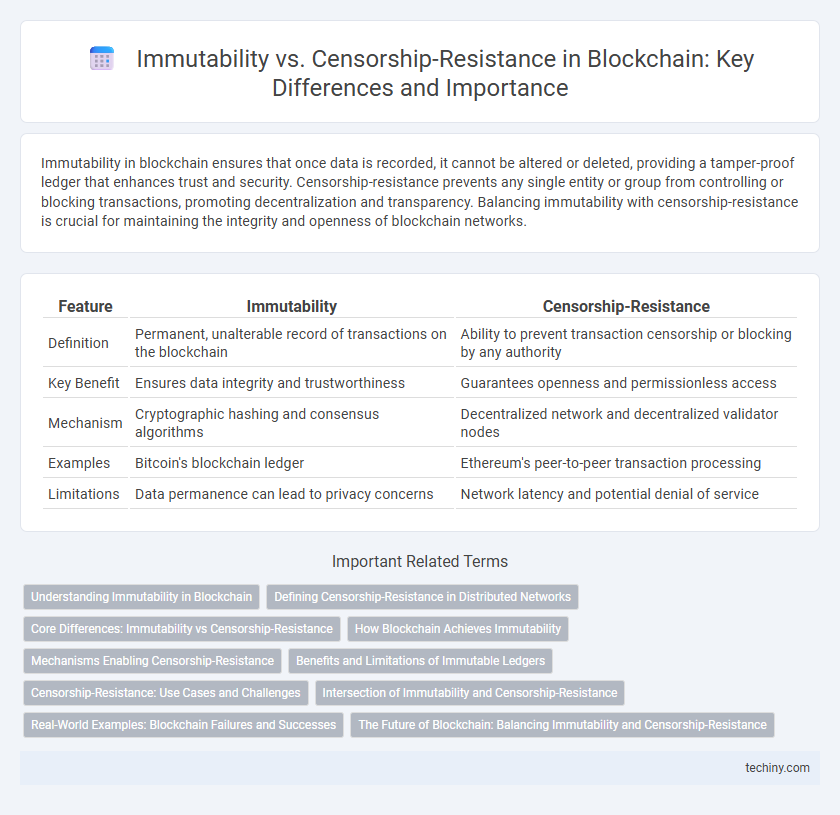Immutability in blockchain ensures that once data is recorded, it cannot be altered or deleted, providing a tamper-proof ledger that enhances trust and security. Censorship-resistance prevents any single entity or group from controlling or blocking transactions, promoting decentralization and transparency. Balancing immutability with censorship-resistance is crucial for maintaining the integrity and openness of blockchain networks.
Table of Comparison
| Feature | Immutability | Censorship-Resistance |
|---|---|---|
| Definition | Permanent, unalterable record of transactions on the blockchain | Ability to prevent transaction censorship or blocking by any authority |
| Key Benefit | Ensures data integrity and trustworthiness | Guarantees openness and permissionless access |
| Mechanism | Cryptographic hashing and consensus algorithms | Decentralized network and decentralized validator nodes |
| Examples | Bitcoin's blockchain ledger | Ethereum's peer-to-peer transaction processing |
| Limitations | Data permanence can lead to privacy concerns | Network latency and potential denial of service |
Understanding Immutability in Blockchain
Immutability in blockchain refers to the permanent and unalterable recording of data across a distributed ledger, ensuring that once a transaction is confirmed, it cannot be modified or deleted. This characteristic is achieved through cryptographic hashing, consensus mechanisms like Proof of Work or Proof of Stake, and the decentralized nature of nodes validating transactions. Understanding immutability is crucial for recognizing how blockchain provides trust, security, and transparency without relying on centralized authorities.
Defining Censorship-Resistance in Distributed Networks
Censorship-resistance in distributed blockchain networks ensures that no single entity can alter, block, or suppress transaction data, preserving the integrity and accessibility of information across all nodes. This attribute relies on decentralized consensus mechanisms, cryptographic security, and distributed ledger technology to prevent manipulation or selective data exclusion. Unlike immutability, which focuses on the unchangeable nature of recorded data, censorship-resistance emphasizes the ability of the network to freely propagate and validate transactions despite attempts at suppression.
Core Differences: Immutability vs Censorship-Resistance
Immutability in blockchain ensures that once data is recorded, it cannot be altered or deleted, preserving the integrity and trustworthiness of the ledger. Censorship-resistance guarantees that no single entity can prevent transactions from being added to the blockchain, maintaining open access and freedom of participation. While immutability focuses on data permanence, censorship-resistance emphasizes protection against transaction suppression and external control.
How Blockchain Achieves Immutability
Blockchain achieves immutability through a decentralized network of nodes that validate and record transactions in a cryptographic chain of blocks, ensuring that altering any recorded data requires an impractical amount of computational power. Each block contains a unique hash that links it to the previous block, creating a tamper-evident ledger where changes are immediately detectable by the network. Consensus mechanisms such as Proof of Work or Proof of Stake reinforce immutability by requiring agreement across multiple participants before transactions are finalized.
Mechanisms Enabling Censorship-Resistance
Mechanisms enabling censorship-resistance in blockchain include decentralized consensus protocols, cryptographic hashing, and peer-to-peer network architecture. These components ensure that no single entity can alter transaction history or block legitimate transactions, preserving network integrity. Advanced techniques like Proof of Work (PoW) and Proof of Stake (PoS) reinforce resistance by distributing validation power across diverse participants.
Benefits and Limitations of Immutable Ledgers
Immutable ledgers ensure data integrity by preventing unauthorized changes, which enhances trust and transparency in blockchain networks. However, their rigidity limits the ability to correct errors or comply with regulatory requirements, posing challenges for dispute resolution and data privacy. While censorship-resistant features protect against control or manipulation by centralized entities, they can also hinder corrective interventions necessary for dynamic or evolving legal frameworks.
Censorship-Resistance: Use Cases and Challenges
Censorship-resistance in blockchain ensures transaction data cannot be altered or suppressed by any central authority, making it crucial for decentralized finance (DeFi), peer-to-peer payments, and secure voting systems. Use cases include enabling free speech on social media platforms and maintaining transparent supply chain records, while challenges involve scalability constraints and regulatory pressures that may impact network neutrality. Solutions often rely on consensus mechanisms like proof-of-stake and layer-2 protocols to enhance throughput without compromising censorship resistance.
Intersection of Immutability and Censorship-Resistance
Immutability ensures that once data is recorded on a blockchain, it cannot be altered or deleted, providing a permanent and tamper-proof ledger. Censorship-resistance guarantees that no single entity can prevent transactions or block data from being added to the blockchain, preserving open and unbiased participation. The intersection of immutability and censorship-resistance creates a secure environment where data integrity and open access coexist, reinforcing trust and decentralization across blockchain networks.
Real-World Examples: Blockchain Failures and Successes
Immutability ensures blockchain data cannot be altered, as demonstrated by Bitcoin's secure transaction history since 2009, preventing fraud and maintaining trust. Conversely, censorship-resistance is exemplified by Ethereum's decentralized applications resisting centralized control, allowing free access to services despite regulatory pressures. However, failures like Mt. Gox highlight vulnerabilities when centralized intermediaries manage private keys, compromising both immutability and censorship-resistance.
The Future of Blockchain: Balancing Immutability and Censorship-Resistance
The future of blockchain hinges on achieving a balance between immutability and censorship-resistance, ensuring that transaction histories remain tamper-proof while enabling recovery from malicious content or errors. Developing scalable consensus algorithms like Proof of Stake and Layer 2 solutions enhances censorship-resistance without compromising the core principle of data permanence. Ongoing innovations in cryptographic techniques and decentralized governance models are pivotal in maintaining this equilibrium, fostering trust and long-term adoption in decentralized ecosystems.
Immutability vs Censorship-resistance Infographic

 techiny.com
techiny.com